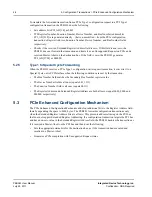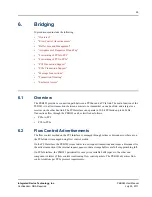
6. Bridging > Forwarding of PCI to PCIe
51
PEB383 User Manual
July 25, 2011
Integrated Device Technology, Inc.
Confidential - NDA Required
•
Memory Read Line if the PCIe Request falls into the prefetchable range defined by the
, and the requested data size is less than or equal to the value specified in
Cacheline Size of the
“PCI Miscellaneous 0 Register”
.
•
Memory Read Multiple if the PCIe Request falls into the prefetchable range defined by the
, and the requested the data size is greater than or equal to the value
specified in Cacheline Size of the
“PCI Miscellaneous 0 Register”
.
The PEB383 supports a single outstanding request. It does not attempt to read beyond the requested
length. The PEB383 decomposes the requests if the requested data length is greater than 128 bytes, and
returns the completions in 128-byte boundary fragments.
The PEB383 uses PCI byte enable fields such that the byte enable information is preserved and no
additional bytes are requested for the transactions that fall into the non-prefetchable address range (for
example, Configuration, I/O, and Memory read commands).
6.6
Forwarding of PCI to PCIe
The PEB383 forwards posted and non-posted requests and downstream read completions to PCIe
devices, and stores the non-posted requests’ state information to return the delayed completions to the
requester.
6.6.1
PCI Memory Write Request
The PEB383 translates the received Memory Write (MW) and Memory Write and Invalidate (MWI)
transactions into PCIe Memory Write Requests. The PEB383 uses a 512-byte posted buffer to post the
received transactions. Write requests are fragmented if one of the following PCIe constraints is met:
•
Address plus length crosses the 4-KB boundary
•
Burst writes with discontinuous byte enables
•
Payload size exceeds MAX_PAY_SIZE in
“PCIe Device Control and Status Register”
The PEB383 terminates a posted transaction with retry only if the buffers are filled with previously
received memory requests, or if the bridge is locked from the PCIe side (see
).
For more information on locked accesses, see
.
















































